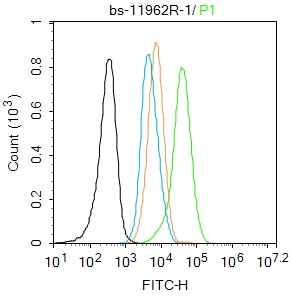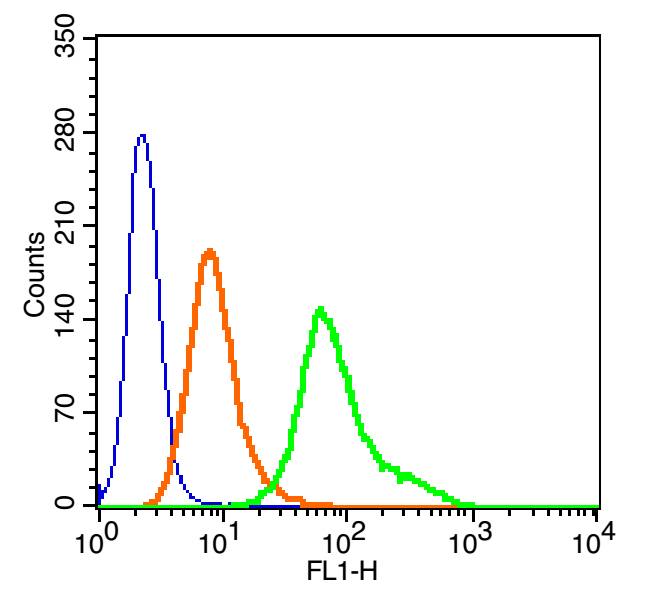
Rabbit Anti-phospho-SNAIL + SLUG (Ser246)antibody
SNAIL + SLUG (phospho S246); p-SNAIL + SLUG (phospho S246); SNAIL + SLUG (phospho S246 + S251); SNAIL + SLUG (phospho Ser246 + Ser251); phospho-SNAIL(Ser246) + SLUG(Ser251); phospho-SNAIL(Ser246) + SLUG(Ser251); dJ710H13.1; MGC10182; Neural crest transcr
View History [Clear]
Details
Product Name phospho-SNAIL + SLUG (Ser246) Chinese Name 磷酸化锌指转录因子Slug+SNAIL抗体 Alias SNAIL + SLUG (phospho S246); p-SNAIL + SLUG (phospho S246); SNAIL + SLUG (phospho S246 + S251); SNAIL + SLUG (phospho Ser246 + Ser251); phospho-SNAIL(Ser246) + SLUG(Ser251); phospho-SNAIL(Ser246) + SLUG(Ser251); dJ710H13.1; MGC10182; Neural crest transcription factor Slug; Protein sna; Protein snail homolog 1; Protein snail homolog 2; Protein snail homolog; Slug homolog zinc finger protein; Slug zinc finger protein; SLUGH; SLUGH 1; SLUGH1; SLUGH2; SNA; Sna protein; SNAH; SNAI 2; snai1; SNAI1_HUMAN; Snai2; SNAI2_HUMAN; Snail 2; Snail homolog 1 (Drosophila); Snail homolog 2; Snail2; WS 2D; WS2D; Zinc finger protein SLUG; Zinc finger protein SNAI1; Zinc finger protein SNAI2. Product Type Phosphorylated anti Research Area Tumour Cell biology immunology Developmental biology Neurobiology Signal transduction Stem cells Apoptosis Zinc finger protein Epigenetics Immunogen Species Rabbit Clonality Polyclonal React Species Human, (predicted: Mouse, Rat, Horse, Rabbit, ) Applications ELISA=1:5000-10000 Flow-Cyt=1μg/Test
not yet tested in other applications.
optimal dilutions/concentrations should be determined by the end user.Theoretical molecular weight 29kDa Cellular localization The nucleus Form Liquid Concentration 1mg/ml immunogen KLH conjugated synthesised phosphopeptide derived from human SNAIL around the phosphorylation site of Ser246: TF(p-S)RM Lsotype IgG Purification affinity purified by Protein A Buffer Solution 0.01M TBS(pH7.4) with 1% BSA, 0.03% Proclin300 and 50% Glycerol. Storage Shipped at 4℃. Store at -20 °C for one year. Avoid repeated freeze/thaw cycles. Attention This product as supplied is intended for research use only, not for use in human, therapeutic or diagnostic applications. PubMed PubMed Product Detail This gene encodes a member of the Snail family of C2H2-type zinc finger transcription factors. The encoded protein acts as a transcriptional repressor that binds to E-box motifs and is also likely to repress E-cadherin. SLUG is involved in epithelial-mesenchymal transitions (EMT) involving E-cadherin repression which is known to play an important role in tumor progression amd neural tube formation. SLUG also has antiapoptotic activity. Mutations in this gene may be associated with sporadic cases of neural tube defects (referenced from Entrez gene).
Function:
SNAIL is involved in the epithelial to mesenchymal transition (EMT) and formation and maintenance of embryonic mesoderm (By similarity). Binds to 3 E-boxes of the E-cadherin gene promoter and represses its transcription. SLUG is a transcriptional repressor, involved in the generation and migration of neural crest cells. PTM: SNAIL is phosphorylated by GSK3B. Once phosphorylated, it becomes a target for BTRC ubiquitination. Ubiquitinated on Lys-98, Lys-137 and Lys-146 by FBXL14 and BTRC leading to degradation. BTRC-triggered ubiquitination requires previous GSK3B-mediated SNAI1 phosphorylation. Similarity: Both SNAIL and SLUG belong to the snail C2H2-type zinc-finger protein family. Tissue specificity: SNAIL is expressed in a variety of tissues with the highest expression in kidney. Expressed in mesenchymal and epithelial cell lines. SLUG is expressed in placenta and adult heart, pancreas, liver, kidney and skeletal muscle.
Subunit:
Interacts with FBXL14 and GSK3B. Interacts with BTRC; interaction occurs when it is phosphorylated on the destruction motif. Interacts (via SNAG domain) with WTIP (via LIM domains) (By similarity). Interacts (via SNAG domain) with LIMD1 (via LIM domains), and AJUBA (via LIM domains). Interacts with LOXL2 and LOXL3.
Subcellular Location:
Nucleus. Cytoplasm. Note=Once phosphorylated (probably on Ser-107, Ser-111, Ser-115 and Ser-119) it is exported from the nucleus to the cytoplasm where subsequent phosphorylation of the destruction motif and ubiquitination involving BTRC occurs.
Tissue Specificity:
Expressed in a variety of tissues with the highest expression in kidney. Expressed in mesenchymal and epithelial cell lines.
Post-translational modifications:
Phosphorylated by GSK3B. Once phosphorylated, it becomes a target for BTRC ubiquitination.
Ubiquitinated on Lys-98, Lys-137 and Lys-146 by FBXL14 and BTRC leading to degradation. BTRC-triggered ubiquitination requires previous GSK3B-mediated SNAI1 phosphorylation.
O-GlcNAcylation at Ser-112 is enhanced in hyperglycaemic conditions, it opposes phosphorylation by GSK3B, and stabilizes the protein.
Similarity:
Belongs to the snail C2H2-type zinc-finger protein family.
Contains 4 C2H2-type zinc fingers.
SWISS:
O95863
Gene ID:
6615
Database links:Entrez Gene: 6591 Human
Entrez Gene: 6615 Human
Entrez Gene: 20583 Mouse
Entrez Gene: 20613 Mouse
Omim: 604238 Human
SwissProt: O43623 Human
SwissProt: O95863 Human
SwissProt: P97469 Mouse
SwissProt: Q02085 Mouse
Unigene: 360174 Human
Unigene: 48029 Human
Unigene: 2093 Mouse
Unigene: 4272 Mouse
Product Picture
Primary Antibody (green line): Rabbit Anti-phospho-SNAIL + SLUG (Ser246) antibody (SL11962R)
Dilution: 1μg /10^6 cells;
Isotype Control Antibody (orange line): Rabbit IgG .
Secondary Antibody : Goat anti-rabbit IgG-AF488
Dilution: 1μg /test.
Protocol
The cells were fixed with 4% PFA (10min at room temperature)and then permeabilized with 90% ice-cold methanol for 20 min at-20℃. The cells were then incubated in 5%BSA to block non-specific protein-protein interactions for 30 min at room temperature .Cells stained with Primary Antibody for 30 min at room temperature. The secondary antibody used for 40 min at room temperature. Acquisition of 20,000 events was performed.Blank control(blue): Hela(fixed with 2% paraformaldehyde (10 min) and then permeabilized with ice-cold 90% methanol for 30 min on ice).
Primary Antibody: Rabbit Anti- phospho-SNAIL + SLUG (Ser246)/AF488 antibody(SL11962R-AF488), Dilution: 1μg in 100 μL 1X PBS containing 0.5% BSA;
Isotype Control Antibody: Rabbit IgG/FITC(orange) ,used under the same conditions.
Partial purchase records(bought amounts latest0)
No one bought this product
User Comment(Total0User Comment Num)
- No comment




 +86 571 56623320
+86 571 56623320




